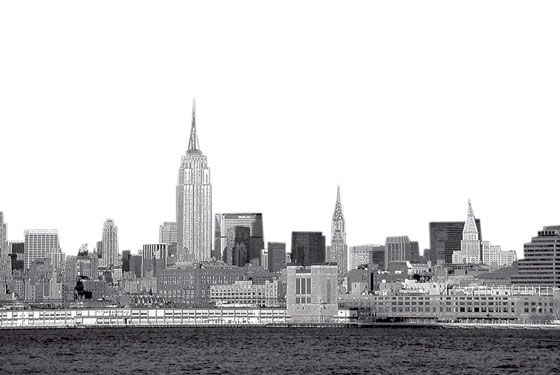
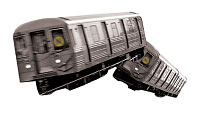
HAZARD: Subway Breakdowns
The pumps that keep tunnels dry enough for the third rail to work are easily overwhelmed, as we found out last week. There’s also the fire problem: Old wiring is flammable (A 2005 electrical fire threatened to close the A/C line for five years.) Switching failures can lead to derailments and collisions (as can human error, as in the Union Square crash that killed five in 1991).
WORRY FACTOR: Much of the pre-WWII signaling system is being replaced.

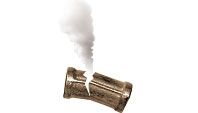
HAZARD: Steam Eruptions
Put it this way: The steam pipe that shut down Lexington Avenue last month was installed in 1924. The oldest stretches of the system are 40-odd years older than that. And nobody really knows what happened yet.
WORRY FACTOR: That hole in the street still looks rather like the jaws of hell.


HAZARD: Blackouts
The national power grid, especially in the Northeast, lacks both redundancy and flexibility. High demand can lead to cascading failures, in which one circuit breaker blows, overloading the next one and the next. We’ve had two blackouts already this summer. Last week, Con Ed begged a section of Brooklyn to use less juice.
WORRY FACTOR: Con Ed is dumping $1.5 billion into rebuilding, but the big blackout of 2003 was caused by grids outside its jurisdiction.


HAZARD: Bricks from the Sky
Nearly everything put up during the sixties building boom is sheathed in a curtain wall that’s one brick thick. Little steel straps attach that façade to the building’s steel skeleton, and those straps are often good for about 30 years’ service before they rust out. Which a lot of them are doing, right now. In 1998, 540 Madison Avenue suddenly started raining bricks.
WORRY FACTOR: Inspections were mandated after the 1998 incident. But there are a lot of white-brick buildings out there.

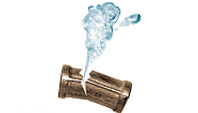
HAZARD: Water-Main Breaks
Heavy road traffic atop old pipes causes vibration and pressure, leading to cracks. (Older water mains are made of cast iron, or, as we like to call it after it’s spent a century in the ground, “rust.”) Even if there’s no dramatic flood, slow leaks can invisibly erode soil for years, until one day your street caves in.
WORRY FACTOR: Nominally unscary, because you probably won’t get burned or crushed. But who wants to end up in a torrent of mud?

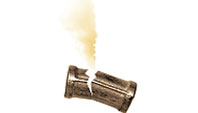
HAZARD: Gas Blasts
We haven’t had a big gas explosion since a Brooklyn main blew up during repairs in 1999. But when they go, they go big. In 1989, a 26-inch gas main exploded on 132nd Street in the South Bronx, scorching a Con Ed plant, shutting down subway service, blacking out much of Upper Manhattan, and killing two people. The flames were visible for ten miles.
WORRY FACTOR: That big 1989 blast wasn’t a spontaneous failure—a backhoe operator hit a pipe by mistake.

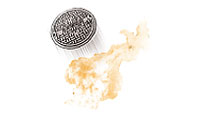
HAZARD: Exploding Manholes
When electrical insulation, frayed from age, the elements, or gnawing rats, smolders, it releases gas and smoke; pressure builds up, then kaboom. (Con Ed replaces 2 percent of its cable annually, which equals a 50-year replacement cycle.) In September 2004, five manholes near the Port Authority Bus Terminal flipped up like silver dollars. Heavy silver dollars.
WORRY FACTOR: Our electrical system is near its capacity, and demand just keeps rising, with new condos and gadgets galore.

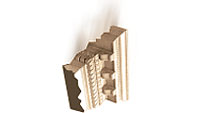
HAZARD: Crashing Cornices
Local Law 10, enacted after a falling cornice killed a Barnard student in 1979, requires regular façade inspections—but only every five years, and only of buildings over six stories. That shabby five-story brownstone down the block from you is exempt. (And a 100-foot steeple on an underfunded, rarely inspected, century-old church counts as one story, by the way.)
WORRY FACTOR: A lot better since the law changed. But you might keep an eye on that church down the block.

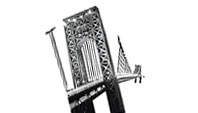
HAZARD: Bridge Collapses
As we all learned last week, the situation in New York is substantially better than it was twenty years ago, when the Williamsburg Bridge came so close to the brink that it was closed for three months. But “better” does not equal “good,” and the most recent inspection of the Brooklyn Bridge rated its approaches “poor.” (They’ll be rebuilt in 2010.)
WORRY FACTOR: After years of scary reports and closures, much of the necessary rebuilding is under way.

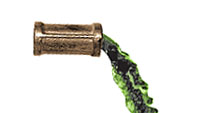
HAZARD: Stopped-Up Sewers
Most days, our wastewater goes to treatment plants. But during even moderate rains, the onrush from storm drains overwhelms that system and runs straight into the river, sweeping the day’s raw sewage along. Christopher Ward, former head of the Department of Environmental Protection, has called it “one of the most overburdened systems in the world.”
WORRY FACTOR: It might not kill you, but it stinks like an unsanitary part of the world you’d prefer to avoid.

Have good intel? Send tips to [email protected].
